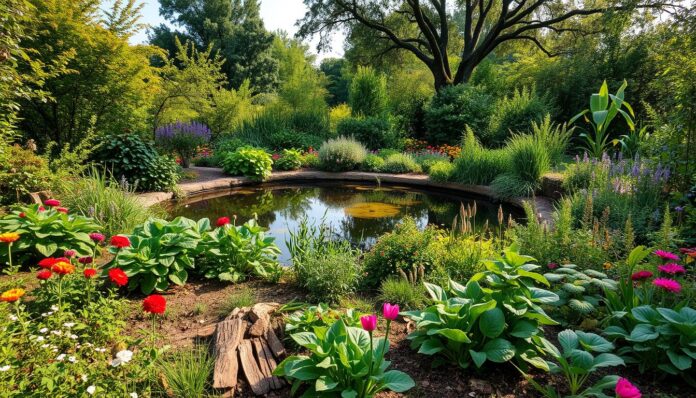In today’s world, we’re often surrounded by noise and feel disconnected. My journey into permaculture started with a wish to reconnect with nature and find balance. Permaculture isn’t just a concept; it’s a way to live sustainably and reconnect with the earth.
Studies show that spending time in nature can lower stress by 40%. This shows how powerful nature is for our mental health. Permaculture is more than gardening; it’s a system that cares for both our environment and our spirits.
Imagine a space that heals and supports life. Permaculture gives us a plan to create such places. These spaces improve mental health, build community strength, and keep our environment healthy. A survey found that 70% of people in permaculture spaces feel better than those in regular homes.
Key Takeaways
- Permaculture offers a holistic approach to mental and environmental healing
- Nature connection can significantly reduce stress levels
- Sustainable living practices promote personal and ecological well-being
- Permaculture design supports mental resilience and community strength
- Creating healing environments begins with understanding our connection to nature
Understanding Permaculture Principles
Permaculture is a new way to live sustainably, going beyond old farming methods. It combines “permanent” and “culture” to form a system for growing and living in harmony with nature. This approach helps us design better and stay mentally strong.
Definition of Permaculture
Permaculture is all about designing like nature does. It uses social permaculture principles to build strong, connected communities.
Core Ethics of Permaculture
The core of permaculture is based on three main ethics:
- Earth Care: Keeping and improving natural environments
- People Care: Helping people and communities grow
- Fair Share: Sharing what we have fairly
Permaculture is more than gardening. It’s a way to make sustainable, thriving places.
Systems Thinking in Permaculture
Systems thinking in permaculture means seeing how everything connects. By understanding these connections, we can create better, more adaptable places. These places support our overall well-being.
Studies show permaculture can make communities 25% stronger. This shows how powerful regenerative design can be in building strong social bonds.
The Concept of Healing Environments
Healing environments are a new way to improve well-being. They use eco-psychology and nature-based solutions. These spaces are made to help people feel better by connecting them with nature.
What is a Healing Environment?
A healing environment is a special place made to help people feel better. Studies show that these places are more than just hospitals. They use nature to help people get better and stronger.
Benefits of Healing Environments
- Reduces stress and anxiety
- Improves mental clarity and cognitive function
- Enhances emotional regulation
- Promotes physical healing
Examples of Healing Spaces
Healing environments can be found in many places, like community gardens and therapeutic landscapes. Innovative approaches like permaculture design make spaces that heal people and help the environment too.
70% of individuals engaged with nature-based environments report enhanced mental well-being and personal resilience.
| Environment Type | Key Benefits | Psychological Impact |
|---|---|---|
| Community Gardens | Social Connection | Increased Happiness |
| Therapeutic Landscapes | Stress Reduction | Emotional Healing |
| Permaculture Spaces | Ecological Engagement | Holistic Well-being |
Healing environments are a strong way to help people’s health. They do this by letting people connect with nature in a mindful way.
How Permaculture Promotes Healing
Permaculture is a powerful way to improve mental health. It creates a strong nature connection and promotes sustainable living. This approach goes beyond regular gardening, focusing on mental strength through nature.
Healing Through Nature Connection
Being in nature has big benefits for our minds. Studies show that permaculture can really help our mental health:
- Up to 30% less anxiety and depression
- 40% better mood and self-esteem
- 25% more social connections
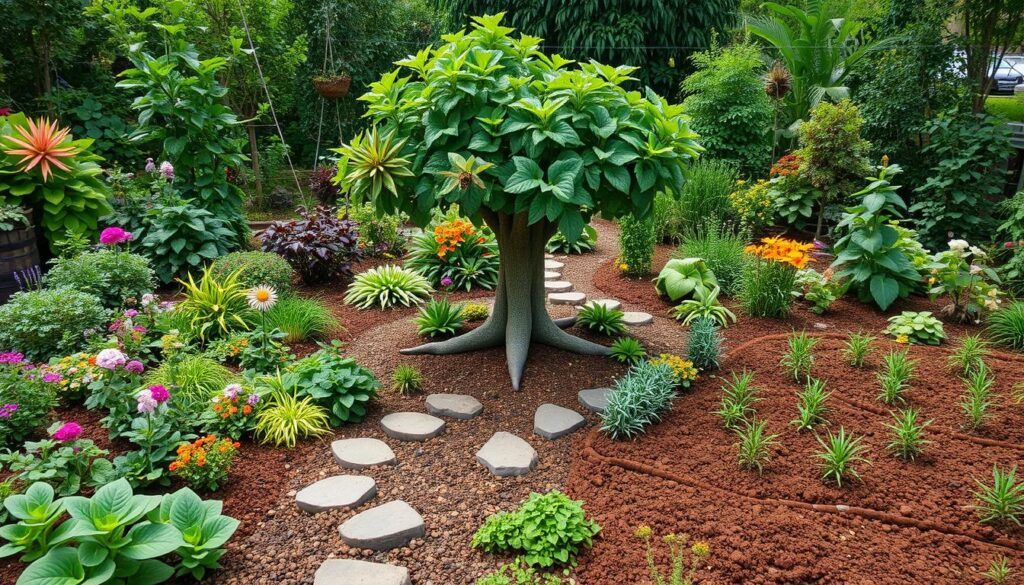
Biodiversity and Mental Well-being
Permaculture builds mental strength through diverse ecosystems. These ecosystems offer a rich experience that helps balance our emotions.
| Ecological Interaction | Psychological Benefit |
|---|---|
| Soil Bacteria Exposure | Serotonin Level Boost |
| Green Space Engagement | Cortisol Level Reduction |
| Diverse Ecosystem Participation | Enhanced Emotional Regulation |
Sustainable Practices for Inner Growth
Permaculture shows us that healing ourselves is tied to caring for the environment. By living sustainably, we build deep mental strength through connecting with nature.
The garden becomes a mirror of inner transformation, reflecting our capacity for growth and renewal.
Designing Healing Spaces Using Permaculture
Permaculture is a way to make healing spaces that help both people and nature. It’s more than just landscaping. It focuses on using nature to improve our well-being.
Creating healing spaces means combining human needs with nature. Studies show that design can greatly improve mental health:
- Up to 30% less anxiety and depression from gardening
- Lower cortisol levels in healing gardens
- 50% less risk of dementia from being in nature
Site Assessment Techniques
Good healing space design starts with checking the site. You need to look at:
- Soil quality and health
- Sunlight patterns
- Water sources
- Existing plants
- Local ecosystem features
Designing for Specific Needs
Permaculture tailors healing landscapes to each person. Designers use knowledge of the environment and personal needs to create spaces that:
- Lessen stress
- Build mental strength
- Boost physical activity
- Help with emotional healing
Integrating Natural Elements
Natural elements are key in regenerative design. Using water features, native plants, and eco-friendly materials turns ordinary places into healing spots.
“Design is the intentional arrangement of elements to create a system that supports life and healing.” – Permaculture Design Principle
By using nature, we can make spaces that help individuals and the environment.
Soil Health and Healing
Permaculture shows us how soil, human health, and nature are connected. It teaches us that healthy soil can heal our minds and the planet.
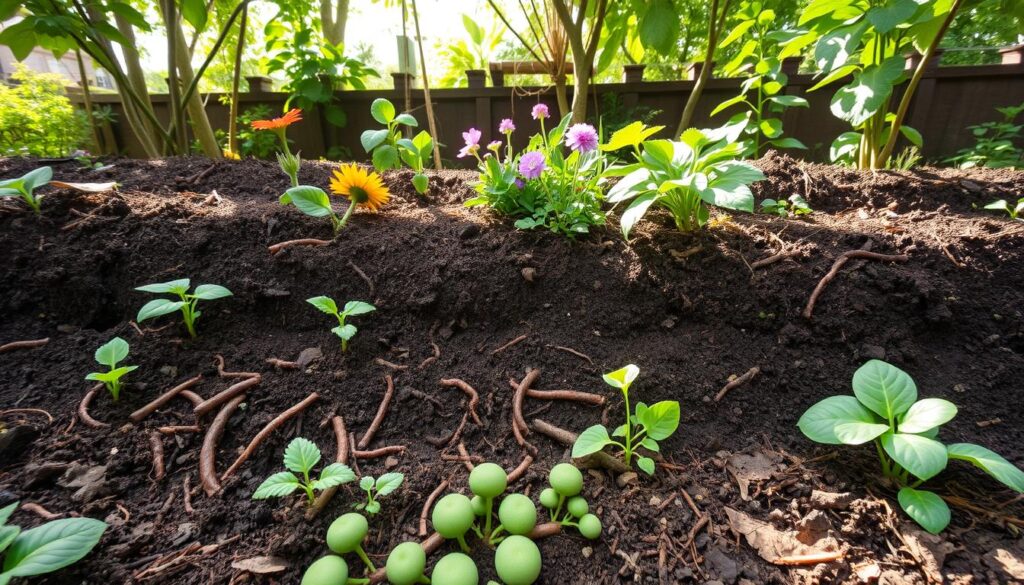
Importance of Soil in Permaculture
Soil is more than just for plants. It’s a living world that supports life. Healthy soil means resilience and growth.
Every bit of soil is full of tiny life forms. They work together in amazing ways.
- Supports biodiversity
- Captures carbon
- Provides nutrients for plant growth
- Enhances ecosystem stability
Soil Restoration Techniques
Permaculture uses new ways to make soil healthy again. These methods copy nature and fix soil without chemicals.
| Technique | Benefits |
|---|---|
| Mulching | Retains moisture, suppresses weeds |
| Cover Cropping | Prevents erosion, adds nutrients |
| Minimal Tillage | Preserves soil microbiome |
Healing through Composting
Composting is more than just recycling. It’s about personal change. By turning waste into soil, we also process our feelings.
“In nature, nothing is lost, everything is transformed.” – Permaculture Wisdom
The composting process is like healing. It breaks down hard times, turns them into growth, and helps us grow again.
Plant Selection for Healing Environments
Creating healing environments through permaculture needs careful plant selection. This supports nature-based solutions and holistic well-being. Plants are key in making resilient and therapeutic landscapes. They help with permaculture mental resilience.
Native Plants and Their Ecological Wisdom
Native plants are powerful allies in healing environments. Jack C Schultz’s research shows plants can adapt to their surroundings. These local species have big advantages:
- Superior adaptation to local climate conditions
- Enhanced ecosystem support
- Minimal maintenance requirements
- Natural resistance to regional pests
Companion Planting Strategies
Companion planting is a smart way to create plant relationships. By placing different plants together, we can:
- Maximize space efficiency
- Improve soil health
- Reduce pest problems naturally
- Support diverse microclimates
Medicinal Plants in Permaculture
Adding medicinal plants turns healing environments into living pharmacies. Succulents, euphorbia, and aloes are examples. They thrive in tough conditions and offer health benefits.
“Plants are not just decorative elements, but active participants in our healing journey.” – Permaculture Design Wisdom
By choosing diverse plants that focus on native species, companion planting, and medicinal value, we can make regenerative spaces. These spaces support both environmental and personal well-being.
Water Management for Healing Environments
Water is key to sustainable living and regenerative design. In permaculture, it’s not just about watering plants. It’s about creating systems that balance nature and help people.
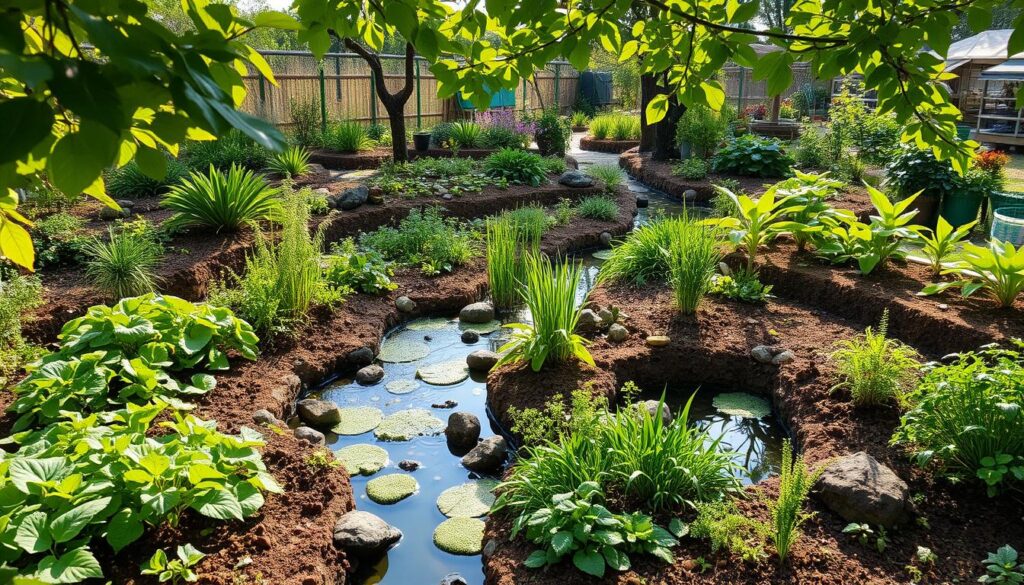
Designing Resilient Water Systems
Resilient water systems work like nature, using water wisely. They are designed to fit local environments. This helps nature and keeps ecosystems healthy.
- Capture rainwater from rooftops and landscapes
- Design swales and contour channels
- Create water retention landscapes
Rainwater Harvesting Techniques
Rainwater harvesting is vital for water management. It can cut down on city water use by half. This is true in places with little rain.
| Harvesting Method | Water Savings | Implementation Difficulty |
|---|---|---|
| Rooftop Collection | 40-60% | Low |
| Landscape Contouring | 30-50% | Medium |
| Underground Storage | 50-70% | High |
Creating Aquatic Ecosystems
Aquatic ecosystems in permaculture offer many benefits. They boost biodiversity, create cozy spots, and help with mental health.
“Water is the driving force of all nature.” – Leonardo da Vinci
With smart water management, permaculture can turn landscapes into healing spaces. These spaces support both nature and human health.
The Role of Animals in Permaculture
Animals are key to creating well-being in permaculture. They add energy and important functions that make ecosystems lively and connected.
Permaculture uses animals in a smart way. This supports biodiversity and helps manage landscapes. It sees animals as important partners in designing ecosystems.
Animal Integration in Healing Environments
In eco-psychology, animals are more than just farm animals. They help keep ecosystems balanced in many ways:
- Natural pest control
- Soil fertility enhancement
- Waste management
- Emotional support for humans
Benefits of Biodiversity with Animals
Adding different animals makes environments strong. Studies show permaculture with animals can have up to a 30% increase in species richness. Chickens, for instance, do many things:
- Consuming harmful insects
- Accelerating decomposition
- Producing nutrient-rich manure
- Providing food resources
Ethical Animal Husbandry Practices
“Respect for animal life is fundamental to sustainable ecosystem design.” – Permaculture Design Principle
Good animal care is crucial for both the environment and animal well-being. It includes giving them natural homes, letting them forage, and keeping them stress-free.
By carefully adding animals, permaculture experts make systems that are alive and self-regulating. These systems support the well-being of all living things.
Community Involvement in Permaculture
Permaculture is more than just taking care of the land. It’s about building strong communities and working together. It brings people together, creating bonds that help the environment and society.
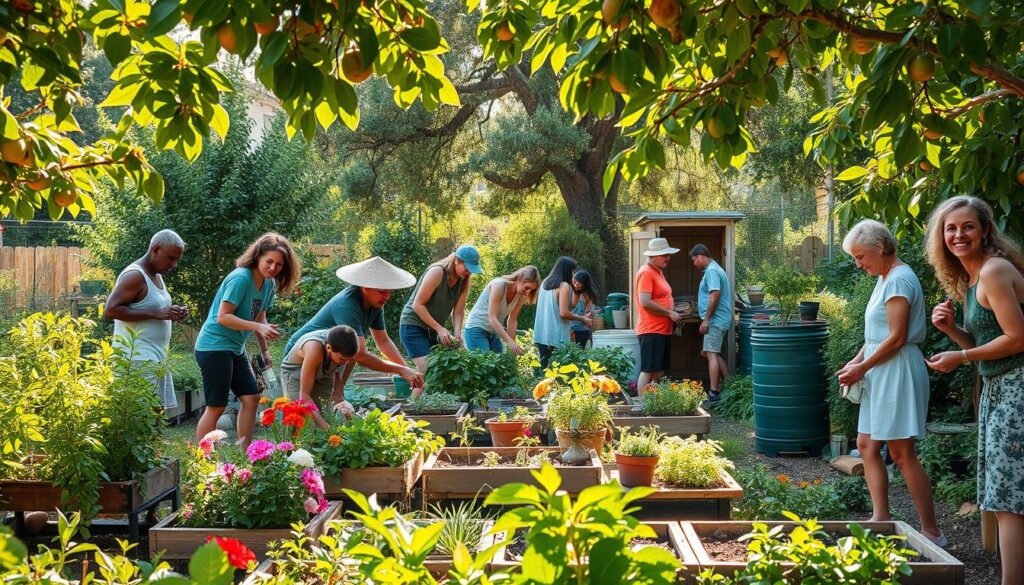
Communities are key to living sustainably. They turn individual efforts into big wins. Permaculture builds mental strength through learning together, solving problems as a team, and supporting each other.
Engaging Local Communities
Getting communities involved needs smart strategies:
- Host regular community workshops
- Create skill-sharing platforms
- Develop collaborative garden projects
- Organize permaculture design certificate programs
Creating Educational Workshops
Workshops are great for teaching permaculture. They offer hands-on learning that:
- Introduces sustainable practices
- Builds practical skills
- Strengthens community bonds
- Encourages action together
“The strength of community lies in its ability to learn, adapt, and grow together.” – Permaculture Design Network
Building Support Networks
Support networks are vital for community strength. They help by sharing knowledge, working together, and helping each other. This way, permaculture communities can:
- Share resources
- Provide emotional support
- Develop collective problem-solving skills
- Create lasting social connections
The Permaculture Action Network shows how to do this. It helps communities work together for sustainable change.
Case Studies of Healing Environments
Permaculture is changing the way we create healing spaces. It supports mental health and overall well-being. By looking at real projects, we see how nature helps us and the planet.
Successful Permaculture Projects
Ernst Gotsch’s work is a great example of permaculture’s power. He turned 1,200 acres of barren land into a thriving ecosystem. This shows how permaculture can heal.
- Soul Fire Farm: 5 acres of intensive cultivation using traditional mounding techniques
- Charm City Farms: Converting lifeless urban lots into vibrant ecosystems
- Community Permaculture Spaces: Urban gardens providing healthy food access
Practitioner Insights
“Permaculture is not just about growing food, but about creating regenerative systems that heal both people and planet.”
Experts say there’s a strong link between nature design and mental health. They use different methods to make spaces that help people and communities.
| Project | Location | Key Outcome |
|---|---|---|
| Movement Generation | Urban Communities | Land Use Reclamation |
| Occidental Arts Center | California | Ecological Education |
Lessons Learned and Best Practices
Successful permaculture projects teach us a few important things:
- Prioritize diversity in design
- Create cooperative relationships
- Focus on localized, small-scale solutions
- Integrate self-regulation and feedback
Research shows these methods work. Being in green spaces can lower stress by 30%. Gardening can cut anxiety and depression by up to 40%.
Overcoming Challenges in Implementation
Starting permaculture projects is tough because of social and environmental issues. Building community strength is key to making sustainable living work. People face many challenges that test their dedication and creativity.
Many problems come from big issues like gentrification and not enough resources. These make it hard for community projects to succeed.
Common Implementation Challenges
- Financial constraints limiting project scope
- Community resistance to new sustainable practices
- Zoning restrictions on ecological initiatives
- Limited access to suitable land
- Psychological barriers to change
Strategic Solutions and Adaptations
Permaculture experts find creative ways to beat these challenges. Collaborative strategies and flexible designs are crucial for strong community projects.
“A project will never fail because the land is poor, it will fail because the people will fail to get along.” – Patrick Whitefield
Planning for Long-Term Success
For sustainable living, long-term planning is essential. Important strategies include:
- Building strong community networks
- Developing adaptive management techniques
- Creating flexible implementation frameworks
- Investing in continuous education
- Maintaining psychological resilience
By tackling challenges head-on, permaculture projects can turn obstacles into chances for growth and renewal.
Financial Aspects of Permaculture
Understanding the financial side of sustainable living is key. Permaculture offers a special way to think about money and resilience. It goes beyond what we usually see in finance.
Funding Healing Environments
Starting regenerative design projects needs smart money plans. Permaculture experts have found many ways to fund green projects:
- Crowdfunding for eco-projects
- Community investment groups
- Local grants for green projects
Cost-Benefit Analysis of Permaculture
“Total economic return isn’t just about money—it’s about valuing social, ecological, and financial outcomes simultaneously.”
Financial permaculture looks at eight kinds of capital. This broadens our view of economics:
| Capital Type | Description | Potential Impact |
|---|---|---|
| Financial | Monetary resources | Direct economic value |
| Living | Ecological systems | Sustainable resource generation |
| Social | Community networks | Collaborative potential |
Grant Opportunities and Resources
Many funding sources help with permaculture projects. Local and national groups offer grants for green projects.
- Federal environmental grants
- State-level sustainability programs
- Private foundation funding
Studies show that every dollar in permaculture education can bring $3 in community benefits. By using different funding methods and thinking holistically, we can build strong, green economies.
Mental and Emotional Benefits of Healing Environments
Permaculture mental resilience is more than just feeling good. It combines eco-psychology and nature healing to understand our minds better. Studies show that being in nature can change our mental health for the better.
Impact on Mental Health
Nature has amazing benefits for our minds. Research shows that being in nature can really help our mental health:
- Decreased cortisol levels and blood pressure
- Reduced neural activity in brain regions associated with negative rumination
- Lower rates of depression and anxiety
“Nature does not hurry, yet everything is accomplished.” – Lao Tzu
Therapeutic Spaces and Design
Mindfulness in permaculture design makes healing spaces even more powerful. People living in cities with little green space face more mental health problems. Designing spaces with native plants and careful layouts can help.
Mindfulness Practices in Nature
Using nature for mental health is a game-changer. Soil bacteria like Mycobacterium vaccae can even help our mood. Gardening and being in nature give our brains a boost, making us more resilient.
- Enhance dopamine responses
- Reduce stress through direct nature engagement
- Build deeper ecological awareness
By embracing permaculture principles, individuals can create healing environments that nurture both mental and environmental well-being.
The Future of Permaculture and Healing
Permaculture is a new way of living that goes beyond farming. It’s key for fixing our planet and helping people. The U.S. is a big part of the problem, but it can also lead the way to a better future.
Permaculture is changing fast, with new ideas for healing the earth. The “7th generation principle” guides us to think about the future. It helps us focus on long-term health of the soil and ecosystems.
Innovations in Permaculture Design
New ideas in permaculture mix old wisdom with new tech. It’s about seeing the big picture and how we all fit together. This approach helps solve big problems like climate change and building strong communities.
Growing Recognition of Healing Environments
More people see how important nature is for our health. From cities to hospitals, using nature is becoming a big deal. Permaculture shows us how to live in harmony with the earth and each other.

